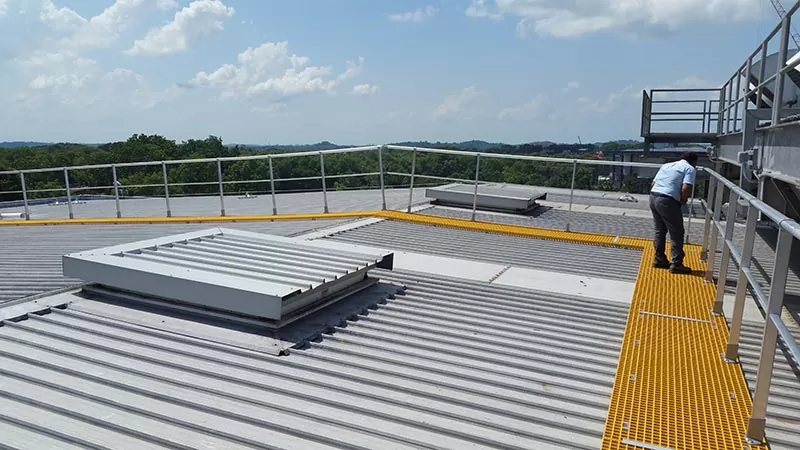In the Philippines, where intense tropical weather and bustling construction activity are common, roof safety is a critical concern. Workers and maintenance personnel often face hazardous conditions while working at height, making it essential to implement effective safety measures. Anti-slip roof walkways offer a practical solution, providing a secure, stable, and slip-resistant surface for those who need to traverse rooftops. This blog explores how these systems enhance safety and protect both workers and roofs.
Understanding Anti-Slip Roof Walkways
Definition and Purpose: Anti-slip roof walkways are specially designed surfaces installed on roofs to create a safe walking path. They are constructed from materials that prevent slipping, even in wet or challenging conditions. These walkways are vital for ensuring the safety of individuals working at height and preventing damage to the roofing material.
Key Features and Materials Used: Anti-slip roof walkways typically feature textured surfaces or slip-resistant coatings that enhance traction. Common materials include high-quality rubber, composite materials, and durable plastics. These materials are chosen for their ability to withstand the elements and provide long-lasting safety.
How They Differ from Other Safety Measures: Unlike traditional safety measures, such as ladders or temporary platforms, anti-slip roof walkways offer a permanent solution. They provide a clear, defined path, reducing the risk of accidents and improving overall safety for regular maintenance activities.
The Importance of Roof Safety in the Philippines
Common Roof-Related Hazards in Tropical Climates: The Philippines’ tropical climate presents unique challenges for roof safety. Heavy rains, high humidity, and intense heat can create slippery surfaces and exacerbate wear and tear on roofs. Workers face risks from wet conditions, falling debris, and unstable walking surfaces.
Statistics on Roof Accidents and Their Impact: Accidents on rooftops are unfortunately common, with many resulting in serious injuries or fatalities. The lack of proper safety measures contributes significantly to these incidents. By addressing these risks with anti-slip roof walkways, the incidence of accidents can be significantly reduced.
Specific Challenges Faced by Workers in the Philippines: Workers in the Philippines encounter several challenges, including extreme weather conditions and varying roof types. Anti-slip roof walkways are designed to address these specific challenges, ensuring that safety is maintained regardless of the environmental factors.
Benefits of Anti-Slip Roof Walkways
Enhanced Safety: The primary benefit of anti-slip roof walkways is the enhanced safety they provide. The slip-resistant surface minimizes the risk of accidents, such as slips and falls, which can have severe consequences when working at height. By offering a stable and level walking path, these walkways help prevent injuries and ensure safer working conditions.
Roof Protection: In addition to improving safety, anti-slip walkways protect the roof itself. By distributing weight evenly and preventing direct contact with roofing materials, they reduce wear and tear, helping to prolong the life of the roof. This preventative measure minimizes the need for costly repairs and replacements.
Improved Efficiency: A well-defined path on the roof enhances efficiency by guiding workers and reducing distractions. With a clear, safe route, maintenance tasks can be performed more quickly and effectively, leading to increased productivity and fewer interruptions.
Installation and Maintenance
Installation Process: Installing anti-slip roof walkways involves several steps, including assessing the roof type, preparing the surface, and securely affixing the walkway system. It is crucial to follow best practices and adapt to the Philippines’ climate to ensure a durable and effective installation.
Best Practices for Installation in the Philippines’ Climate: Given the tropical weather conditions, it is essential to select materials that can withstand high humidity and temperature fluctuations. Proper installation techniques, including thorough surface preparation and secure fastening, are necessary to ensure the walkways perform optimally.
Maintenance Tips: Regular inspection and maintenance of anti-slip roof walkways are vital to ensure their continued effectiveness. This includes checking for wear and tear, cleaning the surfaces to maintain traction, and addressing any issues promptly.
Common Issues and Solutions: Common issues may include surface degradation or debris accumulation. Addressing these problems involves routine cleaning, repair of any damaged sections, and periodic evaluations to ensure the system remains in good condition.
Choosing the Right Anti-Slip Walkway System
Factors to Consider: When selecting an anti-slip walkway system, consider factors such as roof type, climate, and traffic volume. The system should be compatible with the existing roof structure and provide adequate traction for the specific environmental conditions.
Recommendations for Reliable Suppliers and Contractors in the Philippines: Look for reputable suppliers and contractors with experience in installing anti-slip roof walkways in the Philippines. They should offer high-quality materials and have a track record of successful installations.
Cost Considerations and Return on Investment: While the initial cost of installing an anti-slip walkway system may seem high, the long-term benefits outweigh the expense. The reduction in accidents, lower maintenance costs, and extended roof lifespan provide a strong return on investment.
Takeaway
Anti-slip roof walkway systems are an essential investment for enhancing safety in the Philippines. By providing a secure, slip-resistant surface and protecting the roof, these systems contribute significantly to worker safety and overall roof longevity. Property owners and facility managers are encouraged to prioritize roof safety and consider installing anti-slip walkways to reap the benefits of a safer, more efficient working environment.

